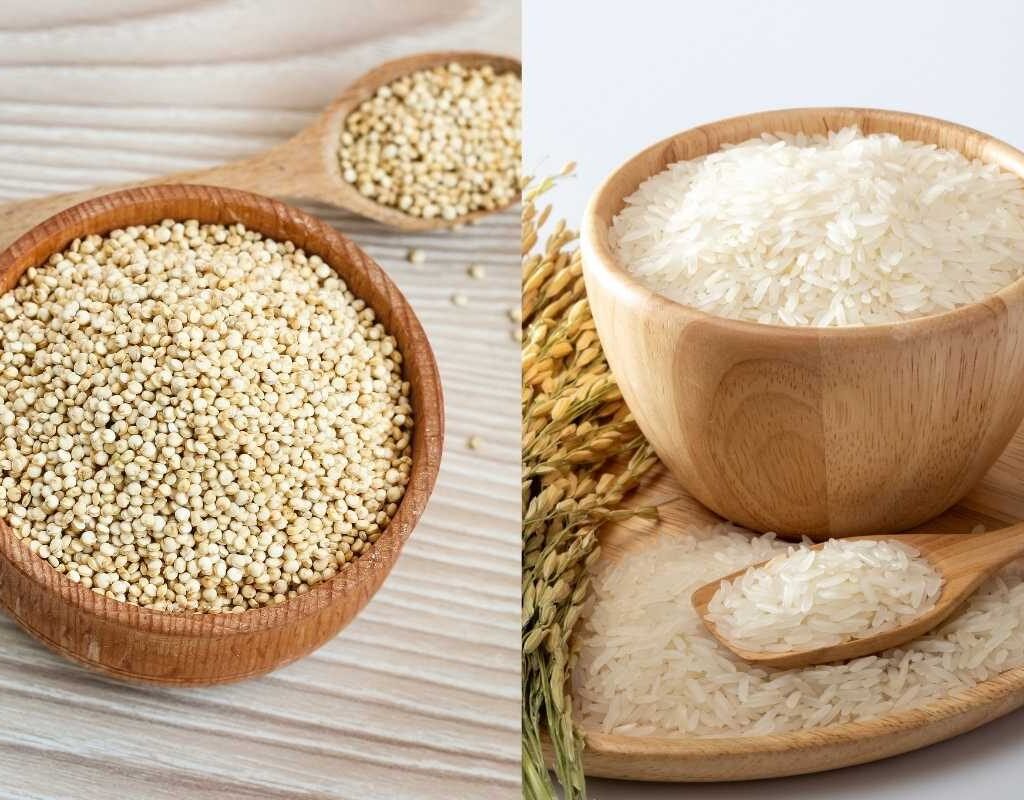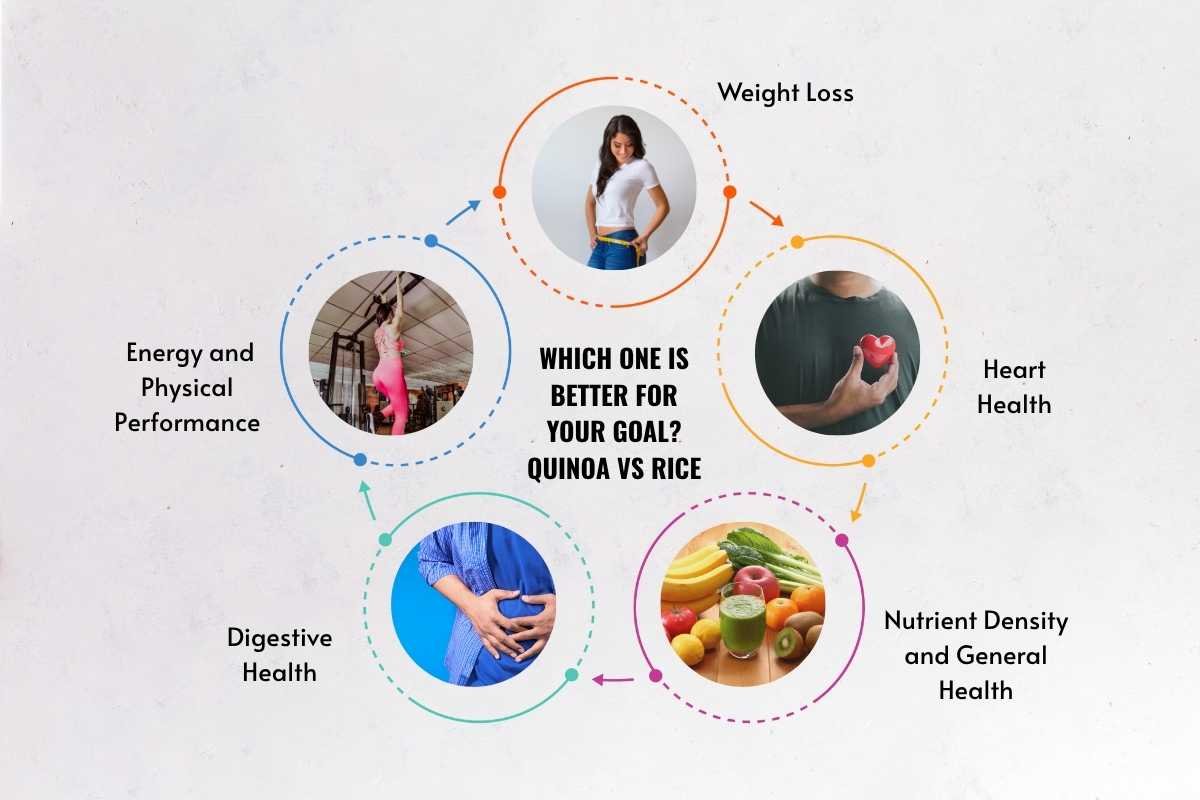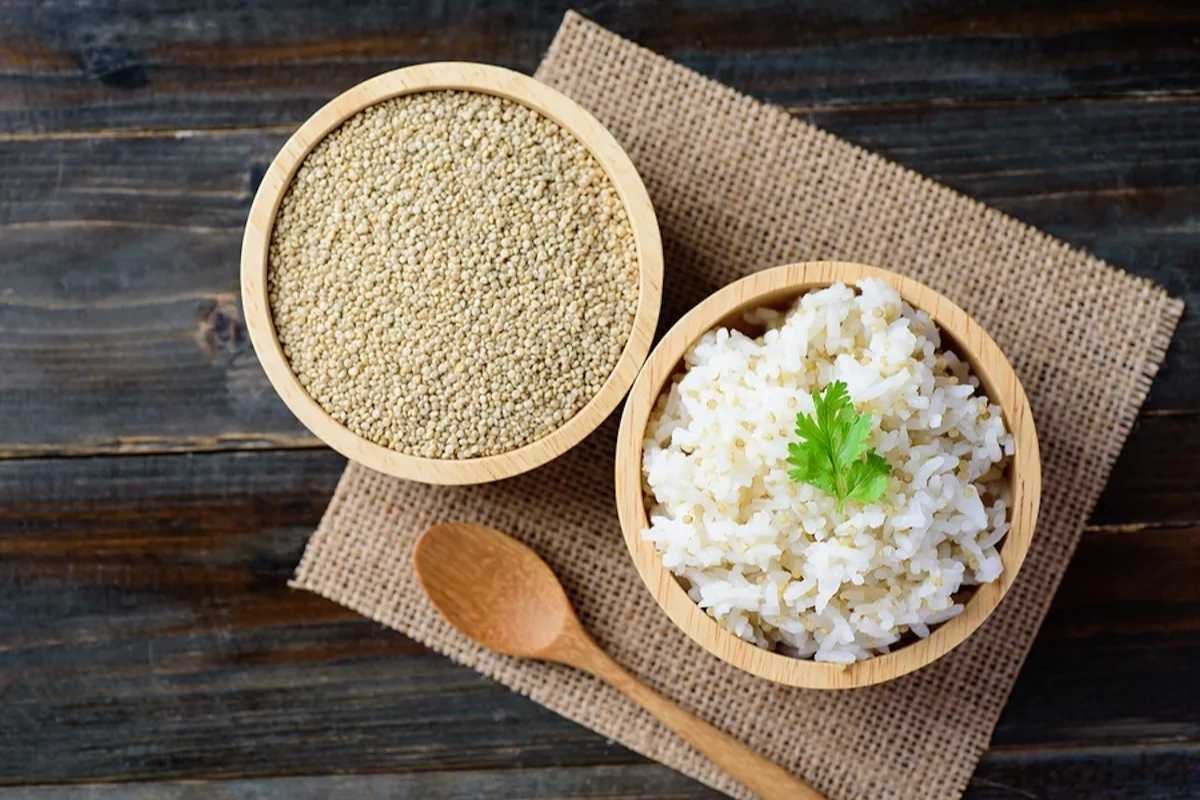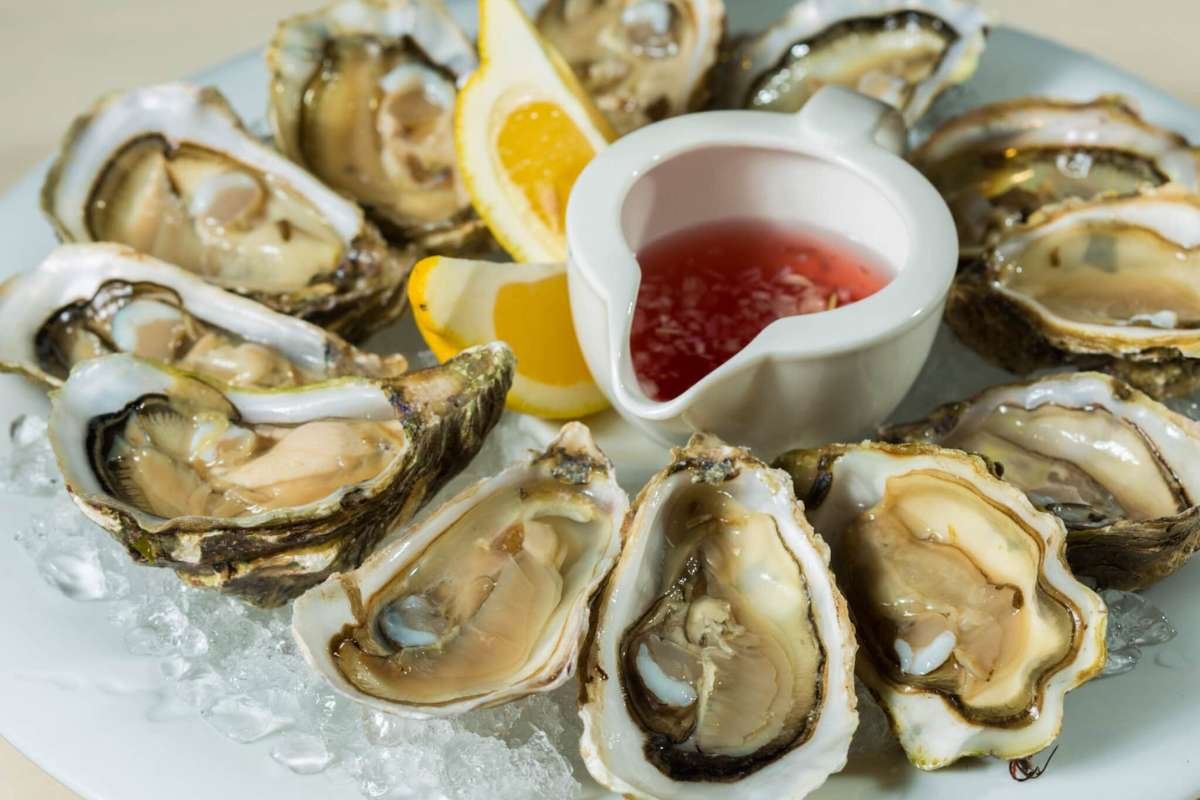People nowadays are moving towards optimal health and fitness. Two ancient grains have initiated a kitchen warfare: Quinoa vs Rice. As we move from eating for nutrition to eating for awareness. The fluffy white grain vs the protein-packed seed. It is an ongoing discussion for the health-minded. Which one is fit to be on the throne for vitamins, fiber, and protein? Is it the globally-loved humble rice? Or is it the trendy, nutrient-dense quinoa that will take its place at your next meal?
Get ready to explore what these kernels have to offer. We find ourselves in a food dilemma. While we are gazing at the data. One can see that it represents a complete protein. And the other is an internationally established baseline in caloric intake. This is a big decision for your overall health and nutrition. Which grain is the clear winner for your plate, you ask? You may not agree with the answer to the debate of Quinoa vs Rice. So keep reading to find out which grain deserves a place in your bowl!
Nutritional Breakdown – Quinoa vs Rice

Quinoa offers a higher nutrient density compared to white rice. It provides more protein, fiber, and essential micronutrients per serving. White rice is primarily a source of carbohydrates and energy. But it is lower in protein, fiber, and key minerals. Quinoa offers a higher nutrient density compared to white rice. It provides more protein, fiber, and essential micronutrients per serving. White rice is primarily a source of carbohydrates and energy. But it is lower in protein, fiber, and key minerals. Below is a structured comparison of their typical nutritional values. As per 100 grams (cooked)
Nutritional Comparison Table:
| Nutrient | Quinoa (cooked, 100g) | White Rice (cooked, 100g) |
|---|---|---|
| Calories | 120–130 | 123 |
| Protein | 4.1–4.4g | 2.7–2.9g |
| Carbohydrates | 21.3–23g | 26–30g |
| Fat | 1.9–3.6g | 0.3–0.4g |
| Fiber | 2.8–5.2g | 0.4–0.9g |
| Iron | 1.5mg | 0.8–1.5mg |
| Magnesium | 64mg | 25–35mg |
| Zinc | 1.16mg | 1.16mg |
| Folate | 19% DV | 1–20% RDI (enriched) |
Key Nutritional Insights
- Quinoa is a complete protein. It contains all nine essential amino acids. Making it superior for vegetarians and vegans.
- Quinoa’s fiber content is roughly three to ten times higher than that of white rice. This supports digestive health and cholesterol management.
- Quinoa contains more iron and magnesium. Vital for energy production and muscle function.
- White rice, especially enriched varieties. It may have added folate and iron. But still lacks fiber and overall micronutrient density found in quinoa.
- Both quinoa and white rice are gluten-free and easy to digest.
Source: https://www.healthline.com/health/food-nutrition/quinoa-vs-rice
Quinoa vs Rice – Health Benefits:
Compared to white rice, quinoa has greater health-related advantages. Let’s get an overview of each grain separately for its benefits. This will help understand the debate of Quinoa vs Rice.
Quinoa Health Benefits:
- Supports heart health. Due to its high antioxidant, fiber, and healthy fat content. This can lower cholesterol and triglyceride levels.
- It may help regulate blood sugar. Because it has a low glycemic index and higher protein. This reduces insulin spikes and cravings.
- It can promote weight loss and help with satiety. Quinoa is richer in protein and fiber than white rice. It increases fullness and supports weight management.
- Improves digestive health by acting as a prebiotic. Boosting gut bacteria diversity and reducing inflammation.
- Offers all essential amino acids as a complete protein. Making it valuable for vegetarians and vegans.
- Provides key micronutrients like magnesium, iron, potassium, and B vitamins. It is often lacking in modern diets.
Rice Health Benefits:
- Provides quick, easily digestible energy. This is beneficial for athletes and those needing rapid post-exercise carbohydrate replenishment.
- It is very low in fat and gluten-free. It is suitable for those with certain dietary restrictions.
- Enriched white rice contains added nutrients such as folic acid and iron. But it is still low in fiber and micronutrients. When it is compared to quinoa.
Key Difference Quinoa vs Rice:
| Aspect | Quinoa | Rice (White) |
| Botanical Type | Pseudo-grain, seed from the Chenopodium quinoa plant | True grain from the Oryza sativa plant |
| Gluten Content | Gluten-free | Gluten-free |
| Texture after cooking | Light, fluffy, slightly nutty | Firmer, more starchy |
| Cooking Time | About 15 minutes | About 15-20 minutes |
| Cost | Generally more expensive | More affordable and widely available |
| Cultivation Regions | Native to South America, grown in high altitudes | Widely cultivated globally, especially in Asia |
| Plant Resilience | Grows in poor soils, drought-tolerant | Requires more water and fertile soils |
| Anti-nutrient Content | Contains saponins, causing bitterness; outer coat needs rinsing | None significant |
| Storage Shelf Life | Shelf-stable for extended periods | Long shelf life, especially white rice |
Which one is better for your Goal? Quinoa vs Rice

Which grain rules supreme for your fitness journey? The complete protein powerhouse, Quinoa. Or the globally-adored staple, Rice? Dive in to learn the perfect fuel for your specific health goals.
For Weight Loss
- Quinoa has a lower glycemic index than white rice. It helps maintain stable blood sugar and reduce cravings.
- Higher protein and fiber in quinoa. This increases satiety and reduces overall calorie intake.
- White rice has higher carbs and causes quicker sugar spikes. This may hinder weight loss efforts.
For Energy and Physical Performance
- White rice is a quick source of digestible carbohydrates. Ideal for rapid energy replenishment post-exercise.
- Quinoa provides sustained energy release. Due to complex carbs and higher protein content.
- Quinoa’s balanced macronutrients support muscle repair better than white rice.
For Heart Health
- Quinoa lowers triglycerides and cholesterol. It reduces cardiovascular risk.
- Rich in antioxidants, fiber, and anti-inflammatory compounds. Quinoa supports overall heart health better than white rice.
- White rice consumption has mixed effects. It is linked to diabetes risk. But not conclusively to heart disease.
For Digestive Health
- Quinoa’s higher fiber promotes gut health and regularity.
- White rice has minimal fiber and less impact on gut microbiota.
- Both are gluten-free and suitable for sensitive digestive systems.
For Nutrient Density and General Health
- Quinoa is richer in essential amino acids. With vitamins like B complex, E, and folate. Alongside minerals like magnesium, iron, zinc, and antioxidants.
- White rice is typically enriched with folate. But lacks the broader nutrient profile of quinoa.
- Quinoa supports immune function and inflammation reduction. It also helps with overall nutrient sufficiency better.
Also Read:
- Brown, Black, or Red? The Healthiest Types of Rice May Shock You
- Jasmine Rice vs White Rice: The Surprising Differences You Didn’t Know
Culinary Versatility and Taste:

The battle of Quinoa vs Rice for plate supremacy often comes down to their culinary profiles.
Rice is the one true global staple. It is recognized for its mild, neutral taste and role as a blank canvas. It absorbs the flavors of sauces, spices, and other ingredients. And the texture of rice can range from fluffy, separate grains. Like Basmati, sticky, creamy textures like Arborio or glutinous rice. This makes it an essential part of Asian. With Middle Eastern, Latin American, and European cuisines.
Quinoa has a stronger, somewhat nutty and earthy taste. This stands out more and provides a distinctively soft, yet chewy texture. With the small “tail” that separates during cooking. Though its stronger flavor is noticeable in a dish. It makes a good “superfood.” Easy to use in salads, bowls, stuffing, or even for breakfast porridge. Overall, quinoa is versatile enough to offer a complete protein and fiber boost. Where a more pronounced grain character supports the recipe.
Case Study: Quinoa vs Rice: The Nutritional Showdown Backed by Science
The case study highlights quinoa’s rise from an ancient Andean staple. And becoming a globally recognized superfood. It is often compared to rice for its nutritional and functional benefits. Unlike rice, quinoa is a “pseudocereal.” Packed with complete proteins, essential amino acids, dietary fiber, vitamins, and minerals. It contains unique phytochemicals such as saponins, phytoecdysteroids, and phenolics. This helps support cardiovascular, metabolic, and digestive health.
Clinical studies suggest quinoa can aid in lowering cholesterol. It also improves digestion and serves as a safe gluten-free alternative. The rice does not provide equally. While rice remains a dietary mainstay worldwide. Due to accessibility and tradition. Quinoa is increasingly seen as the healthier choice. Mainly for long-term wellness and disease prevention. The comparison of quinoa vs rice underscores how dietary shifts toward functional foods. It can help address modern health challenges like obesity, diabetes, and malnutrition. This makes quinoa a strategic grain for the future of global nutrition.
Source: https://pmc.ncbi.nlm.nih.gov/articles/PMC4957693/
Conclusion
The outcome of the battle of Quinoa vs Rice does not equate to taking something away. Rather, it means making a conscious decision. White rice is essential to any global plate. Due to its price, ease of digestion, and neutrality. Nutritional data suggests that Quinoa is the best option for health. Quinoa is packed with protein, fiber, complete amino acids, and micronutrients. Quinoa is a powerhouse grain. Figuring prominently in weight loss, heart health, stamina, and overall well-being. For these reasons, the grain has proven a nutritional win in the present-day. In the pursuit of fitness and overall wellness.
FAQs:
1. Is Quinoa more expensive than Rice, and is it worth it?
Yes. Quinoa is usually more expensive than rice. Due to limited global production and higher demand. However, its nutritional density. They are rich in protein, fiber, healthy fats, and minerals. It often makes it worth the investment. Especially for those seeking a healthier, gluten-free, or more nutrient-packed alternative.
2. Can Quinoa and Rice be eaten together?
Yes. Combining quinoa and rice can offer a mix of taste, texture, and nutrition. Many people enjoy blending quinoa with rice in pilafs, grain bowls, and side dishes. This balance costs, flavor, and health benefits.
3. Which type of rice is closest to quinoa nutritionally?
Brown rice is the closest match. It retains more fiber, magnesium, and antioxidants compared to white rice. However, even brown rice lacks the complete protein profile. With the diverse phytochemicals that quinoa provides.







